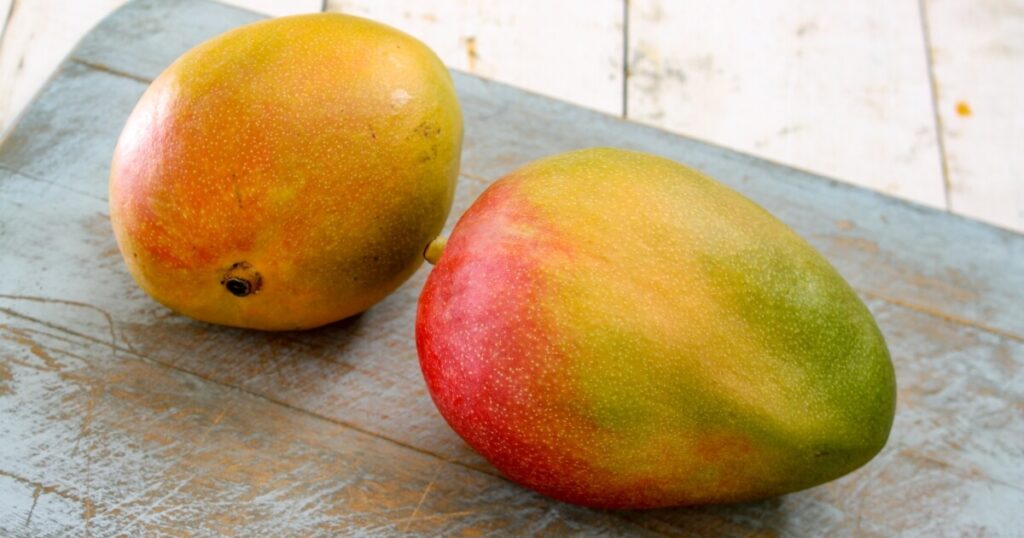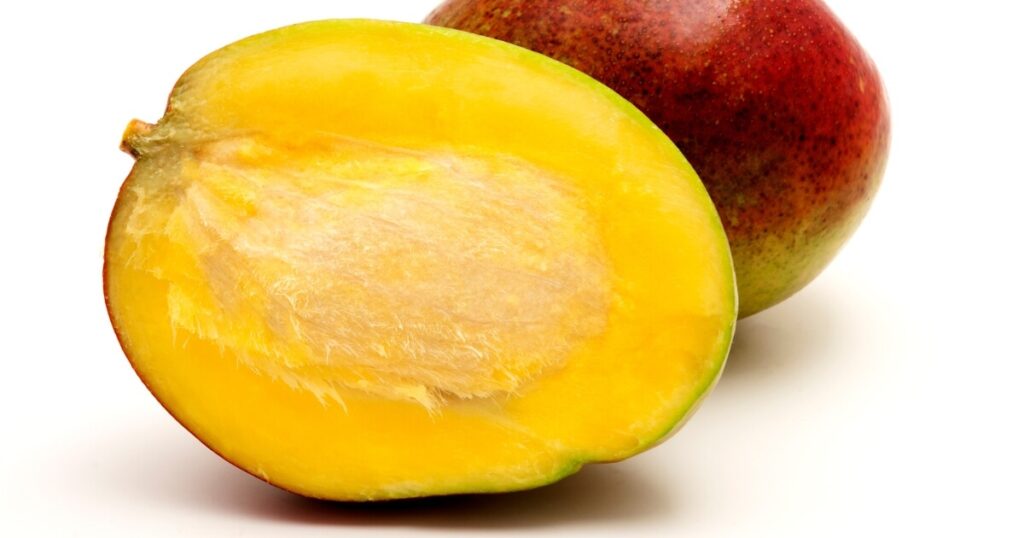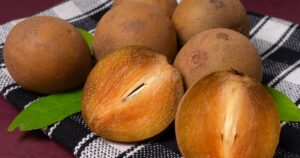The sweet, tropical aroma fills the air as you slice into the ripe mango. You take a small bite, and it’s like a party in your mouth. The taste is sweet, slightly tangy, with a hint of citrus, and oh-so refreshing.
In this article, We’ll discuss the taste of mango, its texture, and the factors that influence these characteristics.
How Do Mangos Taste?
When you bite into a ripe mango, it’s like a flavor explosion in your mouth. The taste is a balance of sweet and tangy, with a hint of citrus. It’s a tropical fruit that is quite popular in grocery stores and hard to resist once you’ve tried a good one.

Types Of Mangos
- Alphonso: You might hear people call Alphonso mangoes the king of mangoes for a good reason. When you bite into one, you’ll find it has a rich, creamy texture that’s not fibrous but full of juice. And when it’s fully ripe, you’ll see that the skin has turned a bright golden-yellow with just a touch of red on top.
- Kent: Originating from Florida, Kent mangoes are large and sweet with a hint of tartness. They have a rich, juicy, tender pulp that’s full of flavor and relatively smooth with a minimal fibrous texture.
- Tommy Atkins: This is the most widely grown commercial variety coming into the United States. The fruit is large with a prominent beak, and the skin color is dark red blush over a green-yellow background. The flesh is mild and sweet with a fibrous texture.
Comparing Mangos With Other Fruits
- Peaches: Peaches have a sweet and slightly tart flavor, similar to mangoes. However, peaches have a more delicate flavor and a softer texture.
- Pineapples: Pineapples are more acidic than mangoes, with a bold and tangy flavor. They also have a more fibrous texture.
- Papayas: Papayas have a milder flavor than mangoes. They are sweet but not as tangy as mangoes and have a buttery texture.
Do Mangos Taste Good?
Mangos are a crowd-pleaser for a reason. Their sweet, tropical flavor can brighten up any dish or be enjoyed on its own. However, the taste can vary based on the ripeness of the fruit. A perfectly ripe mango is sweet and juicy, while an underripe mango can be a bit tart.
Some people might not enjoy the fibrous texture of certain mango varieties. Also, if the mango isn’t fresh, it can taste slightly off. So, consuming them when they’re fresh and ripe for the best flavor experience is important.
Freezing mangoes can be a great way to enjoy them year-round. However, keep in mind that while freezing preserves the flavor, it can slightly alter the texture, making the mango less juicy and a bit more firm.
What Does Mango Look Like?
Mango is a tropical fruit that’s oval in shape and about the size of a medium-sized hand. It has smooth skin that’s green when unripe and turns a beautiful golden yellow, orange, or red as it ripens.

When buying a mango at the grocery store, look for ones that have a slight give when gently pressed, similar to a ripe peach. This indicates that the mango is ripe and ready to eat. Avoid mangoes that have dark spots or blemishes, as these are signs of overripeness or damage.
The smell is also a good indicator of ripeness. A ripe mango has a sweet, fruity aroma at the stem. So, next time you’re at the grocery store, don’t forget to pick up a mango and give it a gentle squeeze and a sniff to find the perfect one!
Do Mangos Have Seeds?
Yes, mangos do have seeds. Inside each mango is a large, flat seed that spans the length of the fruit. The seed is encased in a woody husk, and inside the husk is the actual seed or kernel.

While the seed is technically edible, it’s quite hard and has a bitter taste, so it’s usually not eaten. Instead, the sweet, juicy flesh surrounding the seed is part of the typically consumed mango.
When cutting a mango, navigating around this large seed is important. With a bit of practice, you’ll be able to slice a mango and enjoy its delicious flesh while leaving the seed behind.
How To Make Mangos Taste Good
Mangos are delicious on their own, but there are a few tricks to enhance their natural flavor without adding them to recipes. Here are a few tips:
- Choose the right mango: The taste of a mango largely depends on its ripeness. A perfectly ripe mango will be sweet and juicy. Look for slightly soft mangos to the touch and have a fruity aroma at the stem.
- Chill before eating: Mangos taste great when they’re slightly chilled. After cutting the mango, pop it in the fridge for a bit before enjoying it.
- Add a sprinkle of salt or chili: In many cultures, it’s common to eat mango with a sprinkle of salt or chili powder. The salt or chili contrasts with the sweetness of the mango, making its flavor even more pronounced.
- Squeeze some lime juice: A squeeze of lime juice can enhance the tropical flavor of the mango. The tartness of the lime pairs well with the sweet mango.
Remember, the key to a delicious mango is its freshness and ripeness. So, choose your mangoes wisely and enjoy them at their peak!
How To Use Mangos In Recipes And Side Dishes
Here are some popular ways to use mangos in recipes and side dishes:
Recipes
- Mango Salsa: This is a refreshing twist on traditional salsa. Combine diced mangoes with red onions, jalapenos, cilantro, and lime juice. It’s perfect for dipping chips or topping grilled chicken or fish.
- Mango Smoothie: Blend ripe mangoes with yogurt and a touch of honey for a healthy and delicious smoothie. For an extra kick, add a pinch of turmeric or ginger.
- Mango Ice Cream: Puree ripe mangoes, mix them with heavy cream and sugar, then churn in an ice cream maker. The result is a creamy, tropical treat that’s perfect for hot summer days.
Side Dishes
- Mango Salad: Toss diced mangoes with mixed greens, avocado, and a tangy vinaigrette for a light and refreshing salad. The sweetness of the mangoes pairs well with the creamy avocado and tart dressing.
- Mango Chutney: Simmer diced mangoes with vinegar, sugar, and spices until thickened. This condiment is perfect for pairing with grilled meats or serving with cheese and crackers.
- Mango Rice: Stir fry cooked rice with diced mangoes, coconut, and spices for a tropical twist on fried rice. The sweet mangoes add a burst of flavor to the savory rice.
Remember, the key to delicious mango dishes is ripe, fresh ones.
Mango FAQs
How Do You Know When a Mango is Ripe?
Ripe mangos will give slightly when you press it gently. It’ll also have a fruity aroma at the stem. If it’s hard and doesn’t smell like anything, it’s not ripe yet.
Can You Eat Mango Skin?
While mango skin is edible, it can be tough and taste bitter. Some people may also be sensitive to the compound urushiol found in mango skin, which can cause an allergic reaction.
How Should You Store Mangoes?
Unripe mangoes should be stored at room temperature until they ripen. Once ripe, they can be kept in the refrigerator to slow the ripening process and keep them fresh for longer.
My Tasty Thoughts
If you haven’t tried mangoes yet, you’re missing out on an easy-to-find tropical treat.
Choosing a ripe mango can be a bit tricky. It takes a little practice to get the hang of it.
Also, mangoes have a large seed in the middle that you’ll need to cut around, which can be a bit challenging for beginners. However, I think the delicious taste of a ripe mango is well worth the effort.


